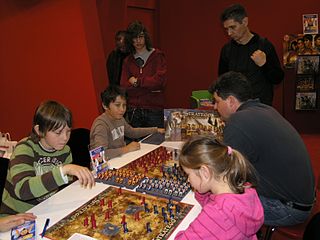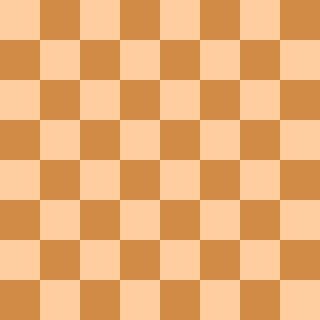
The mancala games are a family of two-player turn-based strategy board games played with small stones, beans, or seeds and rows of holes or pits in the earth, a board or other playing surface. The objective is usually to capture all or some set of the opponent's pieces.

Stratego is a strategy board game for two players on a board of 10×10 squares. Each player controls 40 pieces representing individual officer and soldier ranks in an army. The pieces have Napoleonic insignia. The objective of the game is to find and capture the opponent's Flag, or to capture so many enemy pieces that the opponent cannot make any further moves. Stratego has simple enough rules for young children to play but a depth of strategy that is also appealing to adults. The game is a slightly modified copy of an early 20th century French game named L'Attaque. It has been in production in Europe since World War II and the United States since 1961. There are now two- and four-player versions, versions with 10, 30 or 40 pieces per player, and boards with smaller sizes. There are also variant pieces and different rulesets.

Alquerque is a strategy board game that is thought to have originated in the Middle East. It is considered to be the parent of draughts and Fanorona.

Checkers, also known as draughts, is a group of strategy board games for two players which involve diagonal moves of uniform game pieces and mandatory captures by jumping over opponent pieces. Checkers developed from alquerque. The term "checkers" derives from the checkered board which the game is played on, whereas "draughts" derives from the verb "to draw" or "to move".

Mak-yek is a two-player abstract strategy board game played in Thailand and Myanmar. Players move their pieces as in the rook in Chess and attempt to capture their opponent's pieces through custodian and intervention capture. The game may have been first described in literature by Captain James Low a writing contributor in the 1839 work Asiatic Researches; or, Transactions of the Society, Instituted in Bengal, For Inquiring into The History, The Antiquities, The Arts and Sciences, and Literature of Asian, Second Part of the Twentieth Volume in which he wrote chapter X On Siamese Literature and documented the game as Maak yék. Another early description of the game is by H.J.R. Murray in his 1913 work A History of Chess, and the game was written as Maak-yek.

Breakthrough is an abstract strategy board game invented by Dan Troyka in 2000 and made available as a Zillions of Games file (ZRF). It won the 2001 8x8 Game Design Competition, even though the game was originally played on a 7x7 board, as it is trivially extensible to larger board sizes.
Fox games are a category of asymmetric board games for two players, where one player is the fox and tries to eat the geese / sheep, and the opposing player directs the geese/sheep and attempts to trap the fox, or reach a destination on the board. In another variant, Fox and Hounds, the fox merely tries to evade the hounds. There are several versions known:

Jungle or Dou Shou Qi is a modern Chinese board game with an obscure history. The game is played on a 7×9 board and is popular with children in the Far East. The game is also known as The Jungle Game, Animal Chess, Beast Chess, Children's Chess and Oriental Chess. Jungle is a two-player strategy game and has been cited by The Playboy Winner's Guide to Board Games as resembling the Western game Stratego.

English draughts or American checkers, also called straight checkers, or simply draughts or checkers, is a form of the strategy board game checkers. It is played on an 8×8 checkerboard with 12 pieces per side. The pieces move and capture diagonally forward, until they reach the opposite end of the board, when they are crowned and can thereafter move and capture both backward and forward.

Banqi or Half Chess, also known as Dark Chess (暗棋) or Blind Chess (盲棋), is a two-player Chinese board game played on a 4×8 grid, or half of the xiangqi board. Most games last between ten and twenty minutes, but advanced games can last for an hour or more. Banqi is a social game, usually played for fun rather than serious competition. A more formal version of Banqi may have evolved into the games Jungle and modern Luzhanqi.

Sáhkku is a board game of the Sami people. The game is traditional among the North Sámi, Skolt Sámi, Inari Sámi and Lule Sámi but may also have been played in other parts of Sápmi.

Minichess is a family of chess variants played with regular chess pieces and standard rules, but on a smaller board. The motivation for these variants is to make the game simpler and shorter than standard chess. The first chess-like game implemented on a computer was the 6×6 chess variant Los Alamos chess. The low memory capacity of early computers meant that a reduced board size and a smaller number of pieces were required for the game to be implementable on a computer.

Russian draughts is a variant of draughts (checkers) played in Russia and some parts of the former USSR, as well as parts of Eastern Europe and Israel.

Ming Mang is a two-player abstract strategy board game from Tibet. Ming Mang is also a general term for the word "boardgame" in Tibet. The correct name and spelling of the game may actually be Mig Mang(s), but pronounced Ming Mang or Mi Mang. The term Mig Mang is also applied to Tibetan Go with both games using exactly the same board which is a 17 x 17 square board, and black and white pieces. Mig is in reference to the chart of the board, and Mangs refers to the notion that the more charts are used on the board, the more pieces are needed to play the game, but some state that it means "many eyes". The game may also be known as Gundru. The game was popular among some Tibetan monks before the Chinese invasion of Tibet in 1950, and the uprising in 1959, and among aristocratic families.
Leap Frog is a multi-player abstract strategy board game that was described by H.J.R. Murray in A History of Board-Games Other Than Chess (1898), and attributes its origin to England. Several variants have been created including one by Murray himself which utilizes different colored pieces with different point values. Several players can participate. In the traditional game, players take any piece on the board and use it to hop over and capture other pieces on the board. When no more pieces can be captured, the game ends, and the player with the most pieces wins the game. Murray includes it in the section called Clearance Games which includes the game Solitaire which it does resemble in many ways except that Solitaire is played by only one person. The game is also known to be spelled as one word, Leapfrog.

Zillions of Games is a commercial general game playing system developed by Jeff Mallett and Mark Lefler in 1998. The game rules are specified with S-expressions, Zillions rule language. It was designed to handle mostly abstract strategy board games or puzzles. After parsing the rules of the game, the system's artificial intelligence can automatically play one or more players. It treats puzzles as solitaire games and its AI can be used to solve them.
Jarmo is a two-player abstract strategy board game. According to Tartarian and Polish legend, Batu Khan, the grandson of Genghis Khan, carried this game around during his military campaigns. Supposedly, he would play at least one game before a battle in order to prepare himself. In this game, a player attempts to place as many of their pieces onto the other player's first row. At the same time, the player tries to capture as many of the other player's pieces on the way.
Portal chess is a chess variant which uses at least two fairy pieces called portals. These pieces can be easily added by using poker chips, coins or other suitably sized objects. The game seeks to incorporate portals to allow pieces to teleport around the board. Apart from the portals and their ruleset, the game often plays like ordinary chess, including en passant, castling, and pawn promotion.

Malaysian checkers or Singaporean checkers, is a variant of the board game of draughts played primarily in Malaysia and Singapore, especially among the elder men. Similar to the Canadian checkers, it is played on a 12x12 checkered board. The game can also be played on a 8x8 board if a 12x12 board is unavailable. However, it is distinct from Checkers and Canadian Checkers in terms of its additional rules. Popular alternative names used locally for this game include Dum and Dam.











